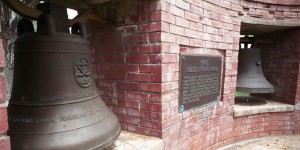Kinks in US-PH ties: Balangiga bells

This May 2001 photo shows the two bells of Balangiga at F.E. Warren Air Force Base outside Cheyenne, Wyoming, that signaled an attack by Filipino insurgents on occupying American troops in 1901. The arrival of President Benigno Aquino on an official visit to the US raises the possibility that the State Department will announce plans to return of the war-trophy Bells of Balangiga to that country. AP
CHEYENNE, WYOMING—Military veterans are stirred up and speaking out against the possibility that the United States might return three church bells seized as spoils of war from the Philippines more than a century ago.
Such a simple gesture would go a long way toward demonstrating goodwill to an old and steadfast US ally in the west Pacific.
The US veterans’ opinion on returning the bells? Don’t even think about it.
“We oppose the return of the bells, period,” said John Stovall, director of national security and foreign relations for the national American Legion.
Two of the three Bells of Balangiga are displayed at F.E. Warren Air Force Base in Cheyenne. They’re part of a memorial to 46 US troops killed by Filipino insurgents in 1901. A third bell is with a US Army regiment in South Korea.
Last week, the US Defense Department sent US Marines Brig. Gen. Richard Simcock to Wyoming to talk with veterans about the bells. The visit was the strongest indication in years, if ever, that US officials are giving serious consideration to returning the bells.
Recent discussion about repatriating the bells has prompted Wyoming’s governor and congressional representatives to tell the Obama administration to keep the bells where they are.
“I strongly oppose any efforts to deconstruct our war memorials that honor our fallen soldiers,” Gov. Matt Mead wrote Secretary of State Hillary Clinton and Defense Secretary Leon Panetta on May 3.
Law to protect monuments
Last month, the American Legion passed a resolution referring to the bells and calling on Congress to pass laws to protect military monuments from foreign governments seeking their removal.
Filipinos revere the bells as symbols of their long struggle for independence. The bells gave the signal for insurgents to attack American soldiers who were occupying Balangiga after the United States took possession of the Philippines following the Spanish-American War.
The issue could come up at the highest levels with President Aquino’s visit to the United States this week to meet with President Barack Obama.
Bargaining chip
Veterans worry the bells have become something of a bargaining chip in US-Philippine relations, said Stovall with the American Legion.
“We think that one, that the bells represent a memorial to these fallen comrades in the Philippines. And two, were we to return the bells, it sets a dangerous precedent for other war memorials around the United States,” he said.
Messages left with the Philippine embassy in Washington, DC, weren’t returned, but a senior White House official said the bells are an important and emotional issue in both countries.
“We will only have an announcement when we have good news, and we will only have good news when we have completed the process that is underway,” the official said Thursday on condition of anonymity.
The modest brick memorial housing the bells at F.E. Warren—a base inaccessible to civilians without advance arrangements—is the only place where the US troops killed at Balangiga have been memorialized as a group, veterans point out.
“That is what represents their death,” said Todd White, an American Legion member from Worland in north-central Wyoming.
Act of revenge
Some 400 machete-wielding Filipinos attacked the 75 or so US troops in Balangiga. Another company torched Balangiga the next day and took the bells as revenge. The reoccupying soldiers took the bells home to Fort D.A. Russell, which eventually became F.E. Warren.
An old English cannon taken from Balangiga is also displayed at Trophy Park in F.E. Warren, a base that oversees dozens of nuclear missiles in underground silos scattered across the prairie. The base doesn’t have any runways but is home to a herd of relatively tame antelope.
Talk about returning the bells has been a perennial issue in US-Philippine relations. Whether the idea moves beyond mere talk this time remains to be seen: The White House official said he didn’t know if the Bells of Balangiga would be discussed during Aquino’s visit.
Solomonic solution
More than 10 years ago, around the centennial of the massacre, former President Fidel Ramos suggested to an AP reporter a Solomonic solution.
Send one bell from the base to the Philippines and keep the other one in Wyoming. Cut each bell in half and send half of each bell to the other country. Weld the bells’ halves together.
“And then we end up with two pairs that are almost identical to the original,” Ramos said.














